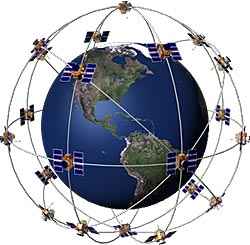Mon, May 31, 2010
GPS IIF-1 Satellite Sends 1st Signals from Space
 The first on-orbit signals from the new GPS IIF-1 satellite,
the inaugural spacecraft in a 12-satellite constellation that the
company is building for the U.S. Air Force have been received. The
signals indicate that the spacecraft bus is functioning normally
and ready to begin orbital maneuvers and operational testing.
The first on-orbit signals from the new GPS IIF-1 satellite,
the inaugural spacecraft in a 12-satellite constellation that the
company is building for the U.S. Air Force have been received. The
signals indicate that the spacecraft bus is functioning normally
and ready to begin orbital maneuvers and operational testing.
A United Launch Alliance Delta IV rocket launched the GPS IIF-1
satellite at 11 p.m. Eastern time on May 27 from Cape Canaveral Air
Force Station. At 2:33 a.m., the satellite separated from the
rocket's upper stage, and a ground station on Diego Garcia in the
Indian Ocean received the first signals from the newest member of
the Air Force's GPS satellite constellation. The Air Force 19th
Space Operations Squadron and Boeing's Mission Operations Support
Center in El Segundo, Calif., confirmed that the satellite is
healthy. GPS signals from the spacecraft payload will be turned on
for test purposes in the coming weeks.
GPS is the U.S. Department of Defense's largest satellite
constellation, with 30 spacecraft on orbit. The GPS IIF satellites
will provide more precise and powerful signals, a longer design
life, and many other benefits to nearly 1 billion civilian and
military users worldwide.
"The inaugural launch of the GPS IIF-1 is a milestone in
Boeing's 30 years of support to the Air Force that goes back to the
first days of this program," said Craig Cooning, vice president and
general manager, Boeing Space and Intelligence Systems. "The new
GPS IIF satellites bring key improvements, including a more
jam-resistant military signal, a new civil signal to enhance
commercial aviation and search-and-rescue operations, and
significantly improved signal accuracy as more of these new
satellites go into operation."
The GPS IIF-1 satellite will undergo months of on-orbit tests,
including functional testing of its payloads and end-to-end system
testing to verify operability with older GPS satellites, ground
receivers, and the ground control system.

Boeing has production of the next 11 GPS IIF satellites well
under way as it implements an innovative pulse-line manufacturing
approach that will help deliver the satellite fleet on schedule.
Adapted from Boeing aircraft and helicopter assembly lines, the
Boeing GPS IIF pulse line efficiently moves satellites under
development from one work area to the next in a steady, pulse-like
rhythm. The second GPS IIF satellite is scheduled for launch later
this year.
More News
Its Offerings Are Lighter, Cleaner, and Now Pushing Past 1,000nm on SAF Jet Fuel DeltaHawk’s diesel-powered aircraft lineup has seen incredible upgrades over the last few yea>[...]
The Airplane Experienced A Total Loss Of Engine Power On December 3, 2025, about 1600 central standard time, a Mooney Aircraft Corp. M20K, N57229, was substantially damaged when it>[...]
Make Sure You NEVER Miss A New Story From Aero-News Network Do you ever feel like you never see posts from a certain person or page on Facebook or Instagram? Here’s how you c>[...]
Aero Linx: European Society of Aerospace Medicine (ESAM) As a pan-European, independent forum, it works to promote the safety and health of all persons involved in aviation and spa>[...]
“We are excited to see Wisk achieve this milestone, and I’m so proud of the team that made it possible. The team at Wisk has built advanced technologies across flight c>[...]
 Aero-TV: DeltaHawks Diesel Power Steps Into the Spotlight
Aero-TV: DeltaHawks Diesel Power Steps Into the Spotlight NTSB Prelim: Mooney Aircraft Corp. M20K
NTSB Prelim: Mooney Aircraft Corp. M20K ANN FAQ: Turn On Post Notifications
ANN FAQ: Turn On Post Notifications ANN's Daily Aero-Linx (12.20.25)
ANN's Daily Aero-Linx (12.20.25) Aero-News: Quote of the Day (12.20.25)
Aero-News: Quote of the Day (12.20.25)




